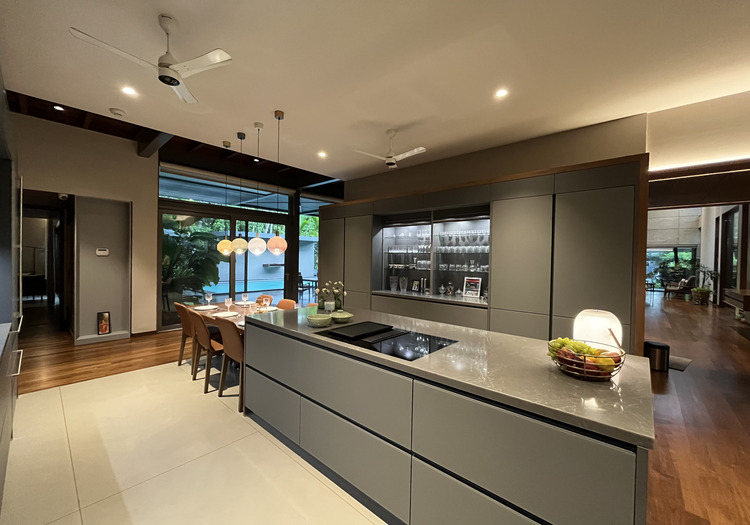If you are about to embark on the journey of designing your first-ever modular kitchen, then you must be wondering how to make it functional. Creating a functional kitchen design is significant, as an efficiently designed kitchen is convenient and also clutter-free. Planning each step carefully is necessary, and to ease your job, we have some ideas to share with you.
Before you select a layout for your kitchen you should consider how to divide it into zones. Dividing a kitchen to multiple zones based on the activities performed there is an effective way to boost functionality. If you take a look at some of the latest modular kitchen designs, you would notice how cleverly each of them has been divided into zones.
In this guide, we will take you through the kitchen zones, and also share tips to help you effortlessly create zones in your modular kitchen.
How to create zones in your modular kitchen: Follow these tips
We should start by discussing these zones first. In a modular kitchen, you perform several activities starting from meal preparation to cleaning. However, you also store ingredients, utensils, and other items in the kitchen and you may also interact with guests.
So, instead of devoting your entire kitchen space to carry out these activities in a random manner, wouldn’t it be best if you create separate zones for carrying out each of these activities and plan that zone accordingly? It will save time; your small modular kitchen will become more organized and absolutely clutter-free. Furthermore, your kitchen work will become more streamlined.
So, what are these zones?
You can divide your kitchen in 6 distinct zones.
- The cooking zone
- The cleaning zone
- The meal-prep zone
- The consumables zone
- The non-consumables zone
- The entertainment zone or the specialty zone
View this post on Instagram
How to design zones efficiently?
We will walk you through each zone separately while sharing tips to enhance the efficiency of each zone.
-
The cooking zone:
The cooking zone is as the name suggests where you cook your food. The cooking zone should be right next to the cleaning and meal prep zone. It allows you to wash vegetables and other ingredients, chop them, and bring them to the cooking area. It should include a spacious designed countertop, a built-in cooktop, and a microwave. This section in your parallel kitchen design should also include a shallow drawer for storing cutlery, cooking tools and gadgets, a spice drawer. The cabinets below should contain the pots, pans, and other necessary utensils.
-
The cleaning zone:
The cleaning zone consists of the sink, the dishwasher, and this is where you can also put the garbage bin. This area is reserved for cleaning vegetables, dirty utensils, and crockery. Install an under-the-cabinet unit where you will store the cleaning supplies, the cleaning tools, and dishwashing liquid. Do not forget to add drying racks where you can put your dishes to dry after cleaning. Under-the-sink cabinets can be used for storing the kitchen towels.
-
The meal-prep zone:
The meal-prep zone is where you prepare your ingredients for cooking. This area requires holders for chopping boards and knives, and small kitchen appliances such as the mixer grinders, blenders, food processors.
While creating this zone in your modular kitchen in Pune, ensure that there are small shelves where you can store the small appliances. You can add racks and hooks to store kitchen tools. If you are into baking then create a small cabinet for storing the baking supplies including the weighing scales, measuring spoons, baking sheets. This zone should contain racks, shelves, and also cabinets to store all essential items in a clutter-free way.
View this post on Instagram
-
The consumables zone:
Modular kitchen storage can be divided into consumable and non-consumable zones. We will start with the consumables zone which contains storage of food items that will be consumed. This zone requires two significant units- the refrigerator and the pantry. The refrigerator would contain the fruits, vegetables, and frozen goods. The pantry on the other hand should contain the dry grocery items, spices. These two units should be placed next to each other. However, also include bottle pull-outs in this zone for storing sauces, oil containers.
This zone should be right next to the meal-prep zone.
-
The non-consumables zone:
Another important segment in the storage zone is the non-consumables zone. In a modular kitchen design, this zone would contain the utensils, crockery, diner plates, coffee mugs, and other appliances. Carefully assess your storage requirement and place the cabinets and drawers. If there is corner space available use magic corners to make the corner cabinets accessible. Use drawer dividers to ensure that different items have been categorized and stored efficiently.
View this post on Instagram
-
The entertainment zone or specialty zone:
This zone should be designed according to the requirement of the user. If you plan on hosting parties in your Bangalore modular kitchen, then let there be a kitchen island with apt seating arrangement. Furthermore, there should be chandeliers or statement pendant lights. However, it could also be your family zone where you want to sit down with your family and interact. You can also turn it into a dry kitchen area where you heat food, make coffee. Place necessary appliances according to your need.
Creating separate zones in the kitchen would ensure that your modular kitchen remains clutter-free and organized. When you plan zones in the kitchen, it helps boost the workflow in the kitchen. Visualize how you would use your modern kitchen and then start planning.


